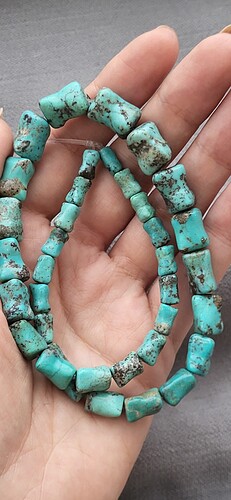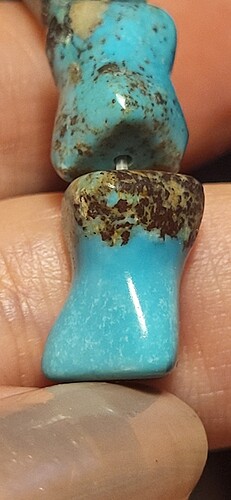Hello, maybe someone help me to identify my turquoise bone shaped beads. This is old, vintage stock pieces. Very beautiful blue green color with many inclusive minerals ( pyrite to)
This is the typical “knucklebone” shape in Chinese stabilized turquoise beads. Without knowing where and when these are from, Chinese is most likely. Given that it’s on plastic stringing, it’s still in jewelry-supply form, rather than being a remnant from what was or is an existing piece of jewelry.
https://www.stachurawholesalegemstones.com/chinese-turquoise-bone-nuggets.html
This high-volume US supplier offers them in what they state to be US turquoise, calling it “dogbone” shape.
Thanks for that information @chicfarmer. I haven’t seen the knucklebone style before.
Thank You so much “chicfarmer” for so informative answering ![]()
Yes, this turquoise I bought is from old stock (never been used in jewelry )
This shape look slightly different than “dogbone” shaped beads, but I believe to - this Chinese turquoise.
May I ask You how long-ago did turquoise stabilization started in China ? Same like in USA, since 1950s ? I mean stabilization with synthetic fillers.
I would guess stabilization of turquoise in China has probably been in use there around the same length of time it has here in the U S, which would be the 50’s. I read on several sources that most Chinese turquoise in use in the United States is stabilized, because much of the “good (i.e. gem grade natural) stuff” has been held back from the American market, thus how Chinese turquoise attained a reputation of being inferior to American turquoise…more a problem of supply rather than quality.
Thank You, Xtina🥰
Does this mean chinese jewelry made in pre 50s (old export China, Tibetan antique jewelry) contains untreated turquoise?
Just need to understand it for comparing visuals.
You won’t be able to know this readily from online photos, or even in person, without either provenance or knowledge of the customary treatments of turquoise in a given locale. Old/ancient turquoise might been “treated” with oils, fat, or wax.
Yes, of cause! Oil or wax this very early method of treatment many surfaces, not only stone. I just intersting only about polymer stabilization, with synthetic filler, and epoxy.
Yes, what @chicfarmer said. ![]() Turquoise isn’t always processed or created the same way. Different artists, cultures, stone cutters, condition and quality of the turquoise when it was mined. Stones are often re-used and can be re-cut or re-polished. And you usually can’t tell just by looking, how it was treated (or not) without some history or provenance, or familiarity with the intricacies of treatment process…and that would be difficult to determine handling it in person, and virtually impossible with only a photo.
Turquoise isn’t always processed or created the same way. Different artists, cultures, stone cutters, condition and quality of the turquoise when it was mined. Stones are often re-used and can be re-cut or re-polished. And you usually can’t tell just by looking, how it was treated (or not) without some history or provenance, or familiarity with the intricacies of treatment process…and that would be difficult to determine handling it in person, and virtually impossible with only a photo.
I’d imagine that even if older pieces had been treated with old-style oils or fats, those eventually wear off and the color could have changed.




